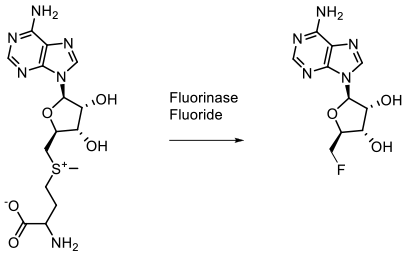Biocatalysis – Fluorinase
Mechanism + Description

Fluorinase acts on SAM like substrates introducing F- via an SN2 reaction.
General comments
Fluorinase and related enzymes are transferases that can deliver fluoride anion to certain substrates via an SN2 type mechanism. The number of substrates accepted by these enzymes are growing, but is somewhat limited by certain key structural requirements of the enzyme. The mild conditions given by enzyme catalysis make fluorinase catalysis attractive for sensitive substrates, especially when 18F is to be introduced.
Enzyme-catalysed electrophilic fluorination is not known. The very high oxidation potential of F2 or F+ equivalents mean that the protein or even water would be oxidised before any substrate, even if enzymic oxidation of F– where thermodynamically feasible.
Key references
Beilstein TV: The flourinase enzyme as a tool for flourine-18 incorporation.
Relevant scale up examples
None found.